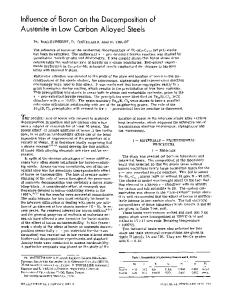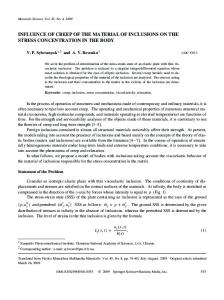The Influence of Oxygen-Rich Inclusions on the Nature of Austenite Decomposition Products of Weld Metal Deposits
- PDF / 903,339 Bytes
- 6 Pages / 415.8 x 637.2 pts Page_size
- 30 Downloads / 303 Views
THE INFLUENCE OF OXYGEN-RTCH INCLUSIONS ON THE NATURE OF AUSTENITE DECOMPOSITION PRODUCTS OF WELD METAL DEPOSITS
M. FERRANTE* AND K. AKUNE* Departairento de Engenharia de Materiais, Universidade Federal de Sao Carlos, 13560 Sao Carlos, Brasil ABSTRACT Recent studies carried out on weld metal have called attention to the role of oxygen-rich inclusions on austenite decomposition. This investigation describes some evidences of the catalytic effect of dislocations upon the y - a transformation. These defects are generated at the matrix inclusion interface and its presence has been ascertained by TEM. Estimates of the stresses arising from differences in thermal contraction between inclusion and matrix on cooling confirm microstructural observations. INTRODUCTION It seems well established that acicular ferrite (AF) is the most desirable microstructural feature in terms of weld metal toughness and that its occurrence is favoured by oxygen levels in the range 200-400 ppm. For instance, Ito & Nakanishi [1] reported high proportions of AF for oxygen contents of about 200 ppm and lath-like structures below this level. Cochrane & Kirkwood investigated a series of welds of nearly constant compositions except for oxygen [2]. According to their model, inclusions tend to restrict austenitic grain growth via a pinning effect. Concurrently, they seem to act as a substrate, leading to enhanced ferrite side-plate (FSP) nucleation. It is apparent that a small austenitic grain size promotes high temperature decomposition products whilst large grain sizes favour bainitic or lath-like structures. Ferrante & Farrar confirmed part of this hypothesis by observing a correlation between austenitic grain size, inclusion volume fraction and microstructure [3]. High-speed dilatometry was employed by Harrison & Farrar with similar results; examining the effects of both very high and very low oxygen levels on austenite decomposition temperature, they reported an inverse correlation [4]. Abson and co-workers [5) proposed a different mechanism according to which AF can be directly nucleated by oxygen-rich inclusions, the main role of which is therefore to reduce local hardenability by making ferrite nucleation easier. Abson emphasizes that the effectiveness of the direct nucleation model depends on the nature of the interface between inclusion and matrix and also of the size of the particle, which ought to be larger than the critical radius for a - Fe nucleation. A similar view was adopted by North & Bell [61 but within a different context where the role of nitrides and the degree of crystallographic matching between these precipitates and ferrite was the important feature. There is a growing body of evidence supporting the direct nucleation hypothesis and recent works by Ricks & Barritte [7], Kayali, Corbett & Kerr [8] seem to point towards the relevance of further studies. Summarizing the present state of knowledge, the effect of deoxidation products is believed to rely on the decrease of hardenability of the weld metal, through the pinning of au
Data Loading...











